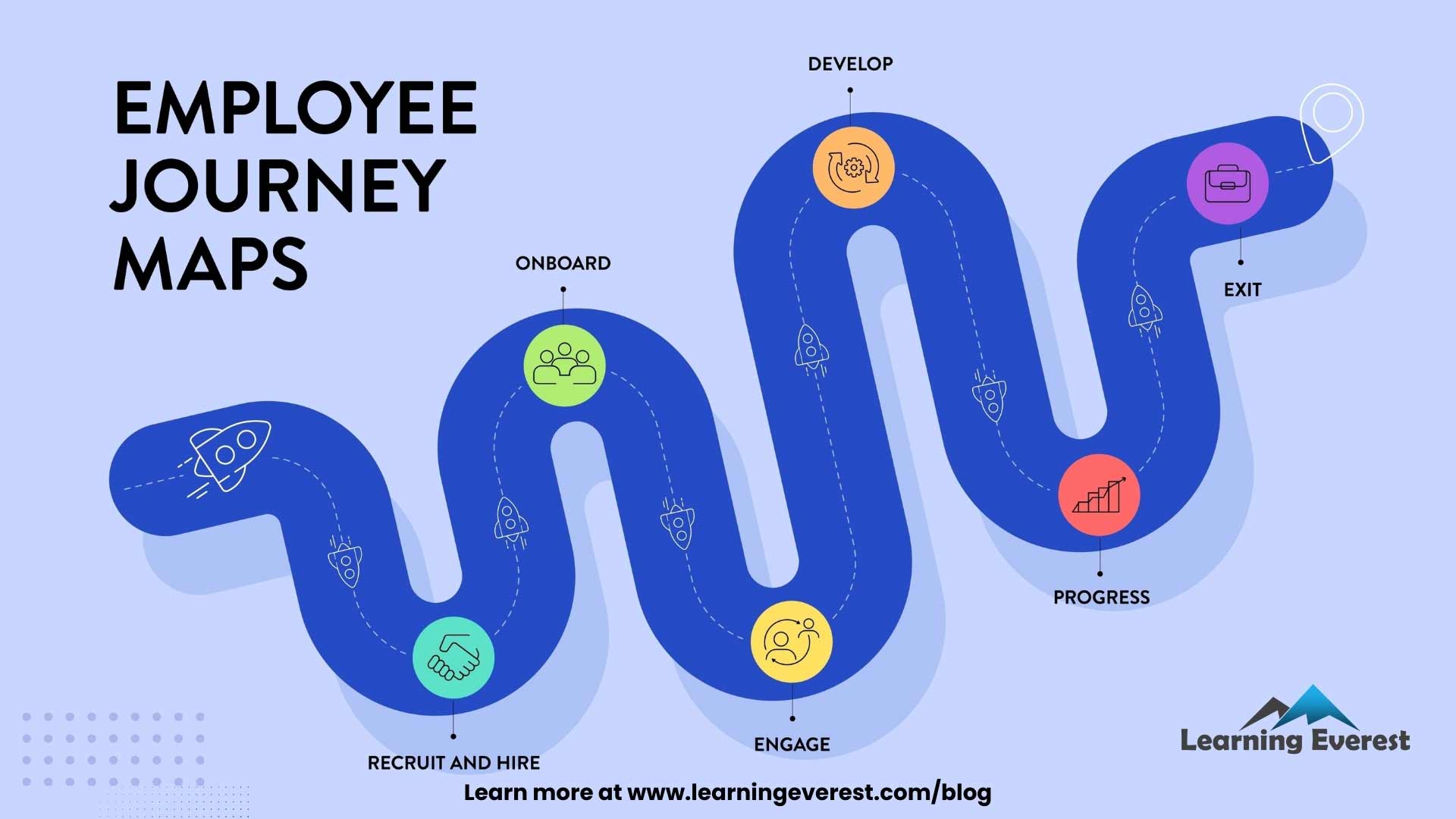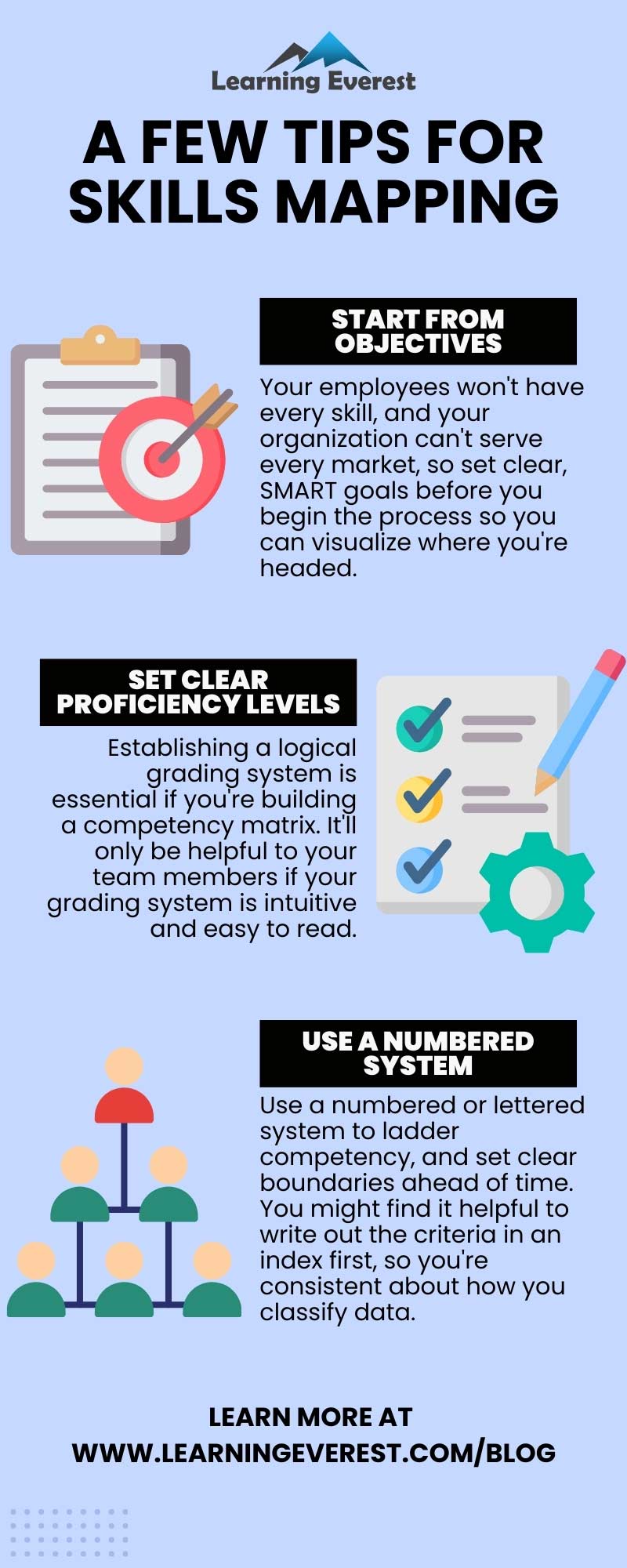What is skills mapping
Skills mapping is the process of identifying the skills (be it hard or soft), knowledge, and abilities of an employee within their job role in an organization. It allows you to understand the cluster of existing skills available in your organization and identify the skill set of every employee. Once this information is gained, it is then visualized using a skills matrix or, in simple words, a visual chart. Presenting the data this way helps organizations compare available skill competencies with needed ones. As a result, it makes employee skill and knowledge gaps more visible so that managers can take steps to improve their organization’s employee training strategy.


Employee Journey Maps
Benefits of skills mapping


Benefits of skills mapping process
Let’s discuss this in detail.
1. Pinpoint skills gaps
Skills mapping can help you recognize which skills or competencies are missing from your organization’s workforce, whether on an individual, team, or organization-wide level. The skills your employees lack could be stopping them from performing their best in their roles and your organization from achieving its overall goals. You don’t want your hard work to go waste just because of a few skill/knowledge gaps that could have been easily addressed with training and development programs. Therefore, it is important that you know which areas need improvement and swiftly create a training plan to address them.
2. Creates effective career paths
To achieve higher levels of retention and job satisfaction, employees need a goal to work towards. Whether it is growth within their current role or an appraisal, they need to know there is a plan in place for their future goals. Skills mapping can give you the tools/resources to accomplish that by bringing to focus not only gaps and areas for advancement but also an employee’s strong skillsets. This knowledge will be very valuable for creating a personal and professional development path that clearly outlines the steps each employee is required to take to advance their professional goals in a way that best suits their strengths and weaknesses.
3. Monitors employee development
Keeping track of your employee performance provides tons of valuable data to the organizational L&D professional about the employee training and development strategy. For example, it highlights employees who need more attention, skills that must be added in the future, types of changes that need to be incorporated to maximize training effectiveness, and additional training, much more. You can easily collect these data by performing skills mapping in fixed time periods, such as quarterly or in every six months, and compare the outcomes. You can also utilize the skills matrix as a visual reference when providing constructive feedback to your employees to help them better acknowledge what steps they need to take moving forward.
4. Improves the hiring process
When you identify the exact skills and competencies each position needs, it is much easier for you to source the right candidates for a job opening. Skills mapping can support the recruiters and HR department in creating a job posting that is much more precise, as well as screening candidate’s resumes with greater speed and efficiency. moreover, skills mapping not only streamlines the hiring process but also increases its odds of organizational success. Hiring people with the right skills minimizes the need for extensive training and development during onboarding and reduces the overall training costs associated with the recruitment process.
5. Achieving effective resource allocation
A significant part of being a good manager is knowing how to match employees with the right job roles. Skills mapping will provide you access to the abilities of each employee so that you can assign them the right job or project and reduce their mistakes. More so, you will be able to create teams with complementary skillsets, thus increasing overall productivity and efficiency. Skills mapping can highlight potential successors for important roles within an organization. By being highly proactive, you can make sure that the transition will be smooth enough when the time comes for someone to move out of the organization.
6. Fosters employee engagement
As we discussed earlier, skills mapping is a valuable tool/resource for improving employee engagement. For one, it keeps employees interested on a daily basis, as it matches them with the job role that best fits their knowledge and skills. Moreover, by identifying your employee’s learning requirements and aligning them with their professional goals for the future, you can build learning and development opportunities that perfectly adapt to their skill/knowledge gaps. It will help waste no time in making them more efficient in their job. All in all, skills mapping can develop a supportive work culture that makes employees feel appreciated and supported by their organization.
The skills mapping process
The process of skills mapping, when completed properly, doesn’t have to be overly complex. The steps include:


Roadmap of skills mapping process
Let’s discuss them in detail.
Step no. 1 – Define the needs and objectives
The first step of the skills mapping process is to define the skills/knowledge you want to assess. These might be the skills/knowledge needed for a specific project or for the department or organization as a whole. You need to establish learning areas and training objectives based on your organizational requirements.
Step no. 2 – Regulate people and skills
With a skills mapping process, the goal is clarity – so don’t put every employee and every skill all in one ability or competency matrix/chart. You should divide employees into teams or groups and evaluate them based on the skills/knowledge relevant to each department. You may also want to have separate skill matrices for hard and soft skills. Skill matrices have many usages, but there’s no need to overcomplicate them. You need to focus on the essential skills/knowledge and competencies needed for each job or task to ensure clarity.
Step no. 3 – Conduct skills assessments
Next, you need to conduct a skills assessment to evaluate employees’ capability level for those skills. There are multiple ways to assess skills, from an actual quiz to a self-assessment to a rating from a team leaders/manager. Skills management software can be used here, offering a visual representation of where your employee’s skills stand. It is also worth asking employees about any skills they may have that aren’t being used in their jobs currently to ensure nothing goes unnoticed. Aside from skills assessments and self-reflection from employees, you should also ask leaders/managers for feedback on the strengths and weaknesses in their team and feedback on areas for improvement.
Step no. 4 – Analyze results
Finally, you will need to analyze the results of the skills mapping to discover insights and decide the next steps. Moreover, useful moments of reflection can be included in the training and development course. It could be stimulated by surrounding environments that offer the possibility of transforming the knowledge collected. This may include comparing the assessment scores of individuals, uncovering skills gaps in the organization, identifying areas where someone needs reskilling and upskilling training, etc.
To sum up
Running a successful organization means utilizing your human capital in the best way possible. And to achieve that, you need to know every employee’s strengths and weaknesses and take the necessary steps to help them upskill. Skills mapping is the most effective tool in helping you recognize necessary skills and competencies within your organization. This process reveals all the actions you need to take to optimize your organization’s employee training strategy and boost efficiency and employee engagement.
Infographic


A few tips for skills mapping
Knowledge check!
Frequently Asked Questions (FAQs)
Q: What is skills mapping?
A: Skills mapping is the process of identifying the skills (be it hard or soft), knowledge, and abilities of an employee within their job role in an organization.
Q: What is the role of skills mapping?
A: Skills mapping helps with workforce planning. It lets you visualize competencies and identify skill gaps (and see who is a good fit for future leadership roles), create better hiring processes, engage your employees, and engage in talent development more effectively.
Q: What is the process of skills mapping?
A: The steps for skills mapping include:
- Step no. 1 – Define the needs and objectives
- Step no. 2 – Regulate people and skills
- Step no. 3 – Conduct skills assessments
- Step no. 4 – Analyze results